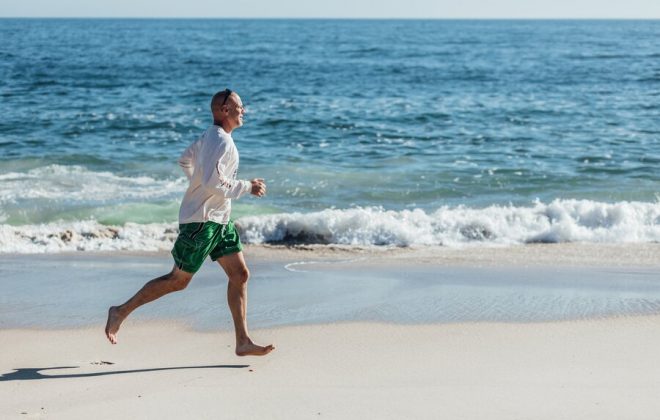First Time Marathoners – 18 Training, Taper & Race Day Tips
There are many questions first time marathoners have in mind before their big race. What should I focus on in my training? How to train a week before the marathon? What should I eat? How to make sure I don’t hit the wall?
And for a good reason.
Marathon is an endurance challenge. If you’ve never completed one, it’s very hard to imagine how the body will respond to several hours of intense exercise.
In this post I’ll share my practical ‘no-nonsense’ tips on how to optimize the marathon training process and get to the race in the best condition.
This post originated as an overview of what I’ve learned from my first marathon. However, over time I updated it with experience from other races as well.
Training tips for first time marathoners
Generally all marathon training plans are similar. There are some technical differences between a plan for a 4:00 hour marathon and a 2:40 hour marathon. But mostly it’s about building a huge aerobic base with easy running and making the stride more economical with speed work.

#1 Stay consistent
The single best thing one can do for building endurance is remain consistent in training. It doesn’t mean pushing through fatigue, but rather doing a form of high or low intensity exercise every day.
Marathon is more than 95% aerobic effort. That means energy is mostly produced by mitochondria in the muscles. The lifespan of mitochondria is ~1-2 weeks and after only a week or two of inactivity (like during a holiday) the body might lose most of the fitness gained through months of training.
On a positive side, mitochondria grow within 24 hours, which is why short but frequent sessions are very effective. For instance, when absolutely pressed for time, a 10-20 minute plyometric session or 10 hard 15-second strides is great for marathon training.
#2 Go long and easy
Apart from endurance, marathon requires a massive amount of strength to withstand hours of pounding. For first time marathoners the most important session of the training plan is the long run. Consistent prolonged easy running strengthens leg, glute & core muscles required to complete the distance.
It’s important to start with a short distance and gradually add volume every week. Doing so will allow the body to adapt to the distance and grow stronger. Only once one can ‘comfortably’ complete a 2 hour easy run it makes sense to add some race pace intervals. Not until then.
Related: Marathon Long Run Variations – 5 Sessions To Boost Endurance Gains
#3 Train in the morning
The best way to include a lot of running in an already busy schedule is to do it early in the morning. That’s when all of the world is asleep and nobody can bother you. Also, when athletes complete a session in the morning, then they’re done for the day.
The likelihood to skip a session in the evening is much higher, because a lot can come up during the day. Training in the morning helps to stay consistent.
#4 Add a fasted session at least once per week
Training on an empty stomach stimulates the body to burn fat for fuel more efficiently and rely less on carbs. That is very important for marathon runners, because the amount of stored glycogen (carbs) and all the gels during the race will not be enough to complete the distance.
The more trained the body is at burning fat, the easier the effort will feel and the faster the athlete will be able to run.
If you’re training on an empty stomach, stick to easy running. A harder session will require carbs and a proper breakfast ~2 hours in advance.
#5 Include 1-2 strength training sessions per week
Strength training helps to improve running form, efficiency and, ultimately, speed. While most of runner’s strength comes from specific running sessions, adding a dedicated session in the gym is also very helpful.
However, runners don’t train for size, so the program should include only explosive movements or bodyweight exercises, like core training.
Explosive movements can be either a form of plyometric jumps or exercises on big muscle groups – no more than 2-3 sets of 1-2 repetitions with 80%+ of maximum load (5min recovery between).

The Resilient Athlete
A Self-Coaching Guide to Next Level Performance in Sports & Life
Are you aiming to become a resilient athlete who is able to withstand any pressure? Be able to jump on any opportunity? Take any challenge life throws at you head on?
Then this book is for you.
Learn more#6 Add volume by cross-training
Cross-training helps to overcome running fatigue that might accumulate due to lots of hours of ‘pounding’ on the road.
Swimming and cycling are two of the best cross-training options for runners. Swimming builds strong core and improves running form and cycling is a very effective way to maintain aerobic base. In fact,
By adding long easy bike rides one can easily add 20% of quality volume without much impact on muscles and joints.
#7 Don’t skip the warmup
Warm up before the session or a race improves performance and prevents injuries. On top of that, consistent warm ups help to minimize muscle tightness and maintain flexibility.
#8 Fuel up for intense sessions
Timing and quality of nutrition is critical to optimize recovery time and allow the body to train more.
Leave at least 2 hours before a training session to digest the food and include as much vegetables as possible to assist the body with muscle repair.
Related: 14 Key Steps To An Effective Marathoner And Triathlete Diet
#9 Push when it counts
Do whatever you can to recover for long runs and speed sessions. That way the body will be able to tolerate more load and grow stronger.
Outside of the key sessions (i.e. on easy days) run very easy and monitor your recovery.

Tapering tips for first time marathoners
Tapering for a race is critical to recover completely and absorb all the training. This will allow the body to produce the best performance. There’s nothing more frustrating than not feeling 100% ready on race day after months of hard training.
To taper for a race athletes need to cut down on training in the weeks leading to the race. But not too much to start detraining. Remember, the lifespan of mitochondria is ~1-2 weeks only.
#10 Cut the volume down progressively
For a 2 week taper cut the volume down 30% on the first week and another 50% down on race week. For a 3 week taper – cut the volume down by 30% on two consecutive weeks and by 50% on race week.
If the average volume is around 5 hours per week, then a two week taper would be 3.5 hours on week 1 and 1.5 hours on race week.
Also, to avoid accumulating fatigue, on race week it’s best to keep training sessions short – 20-30 minutes
Related: Marathon Taper Tips And My 2 Week Marathon Taper Schedule
#11 Focus on race intensity
During the taper period it’s important to keep the intensity. Sitting on a couch or only running easy will force the body to lose the speed that took so much time to build.
It’s best to maintain the usual intensity, but make the intervals progressively shorter (i.e. by 30%-50% like the volume). On race week a good tactic is to do fartlek sessions (short speed pickups) at race effort.
#12 Move the body more
After a long period of training some of the muscles can get tight. During taper weeks it’s important to help the body relieve the tightness and promote the blood flow.
Stretching is a good solution, but don’t hold stretches for too long. Try to move through the stretch and open up the joints. Replicating some of the poses from yoga is a great way to relieve muscle tightness.
Avoid scheduling a massage on race day. It puts a lot of pressure on the muscles and causes muscle damage. With the race coming closer it’s too much of a risk.
Race day tips for first time marathoners
Marathon is a strategic race. You can’t approach it like a 10K or even a half marathon. The race is longer than 2 hours (for most it takes much more than that), so you can’t just gut it out until the finish line if you’ve started too fast.
First time marathoners often start too fast and end up burning through reserves quickly. This generally leads to athletes having to slow down or even revert to walking at around 30-35K. That’s where all the ‘I was on sub 3 hour pace until 30K’ stories come from.
#13 Leave the ego at the start
First of all, if you have a goal race time – better forget it. It was useful to know it during training, so that the body can get used to that pace. However, on race day there’s a lot that can impact performance. It’s important to listen to the body and feel what it’s capable of, not try to run faster than you can.
If you continue to push beyond what body is capable of, you’re setting yourself for a very long and painful finish.
#14 Run first 2K as a warmup
For first time marathoners start experience can get very stressful. First 10 minutes or so are often very hectic, as everyone tries to overcome each other and get into a good position. With all the adrenaline it’s easy to burn a lot of matches here.
Don’t even think about getting into the rhythm during the first 2K. There will be plenty of time for that. Think of the first 2K as a warm up and enjoy the vibe.

#15 Pace in thirds
The most effective way to run a marathon is, obviously, at an even pace. However, maintaining the same pace will become increasingly harder as you progress due to muscle fatigue. To compensate that effect, I found ‘pacing in thirds’ strategy to be most effective. Start a bit slower and build up as you go:
- First 2K – easy.
- After the first 2K try to run the next 12-14K at conversational pace. That’s around 5 out of 10 on a ‘rate of perceived exertion’ scale.
- The middle portion of the race – around 15K to 32K – should still feel easy. Effort-wise that’s a 6 out of 10.
- 32K is where the marathon actually starts. Up until now it was all about conserving energy. From here it will get increasingly harder to continue, but if you’re still feeling fresh – this is the time to push a bit. The effort at this point should feel around 7 out of 10.
- If you still have the energy in you, leave it all on the last 2K. If you run out of steam, there’s not much more left.
From heart rate perspective first time marathoners should pace their race in Zone 3. Start in low Zone 3 and increase a bit as they go.
#16 Drink at every aid station
Regardless of the effort, the body loses a lot of fluids during the marathon. Dehydration causes loss of power, energy and may even lead to muscle cramps.
Often when an athlete feels thirst he’s already dehydrated. To avoid that it’s best to drink a bit at every aid station.
#17 Don’t under- or over-fuel
In terms of fueling, I found that 45 grams of carbs per hour is optimal for running. More than that may cause stomach problems and less than that will lead to premature fatigue.
45 grams per hour translates to roughly one gel every 40 minutes. Drink plenty of water with it to make sure the body absorbs it well and to avoid stomach issues. I learned this myself the hard way in my first Ironman.
Also, having electrolytes in the gels you’re using will help the body to prevent dehydration and stay ‘more fresh’ throughout the race.
#18 Have a ‘throwaway’ shirt
It’s better to dress light for the marathon. However, if the weather is between 7 and 12 degrees it might be cold at the start. So, a good idea is to put on a shirt or a jumper you don’t need to keep you warm before the start.
You can throw it out right before the start or wear for those first easy 2Ks. Volunteers will usually pick up discarded clothes and donate to charity.
Marathon is an intense effort – it’s hard to get cold while running it. Unless it’s less than 5 degrees out.
Did you find this information useful? Share the post with others using the buttons below.
Have an opinion? Share via links below and tag @theathleteblog
Tags In
Andrejs
GET A FREE TRAINING PLAN
Subscribe to my email list and get access to a free 4-week “back in shape” training plan
You’ll also get two full-body strength sessions and some other goodies!

How did I get here?
Hey there! My name is Andrejs and I am here to inspire, entertain and get you fit for any adventure.
I went from being an over trained pro athlete to an endurance coach sharing how to listen to your body and live life to the fullest.
Traveling, new sports & activities brought new meaning to my training and made it much more effective, fun and enjoyable. And I'm here to help you do the same.


